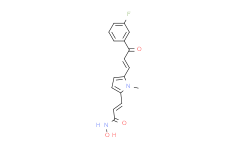| Cas No.: | 852475-26-4 |
| Chemical Name: | Hdac-IN-1 |
| Synonyms: | MC1568;(E)-3-[4-[(E)-3-(3-fluorophenyl)-3-oxoprop-1-enyl]-1-methylpyrrol-2-yl]-N-hydroxyprop-2-enamide;MC-1568;MC1568 (MC-1568, MC 1568);(E)-3-(4-((E)-3-(3-fluorophenyl)-3-oxoprop-1-enyl)-1-methyl-1H-pyrrol-2-yl)-N-hydroxyacrylamide;MC-1568,MC1568;3-[5-(3-(3-Fluorophenyl)-3-oxopropen-1-yl)-1-methyl-1H-pyrrol-2-yl]-N-hydroxy-2-propenamide;HDAC-IN-1;MC 1568;3-(4-(3-(3-fluorophenyl)-3-oxoprop-1-enyl)-1-methyl-1H-pyrrol-2-yl)-N-hydroxyacrylamide;(E)-3-(4-((E)-3-(3-fluorophenyl)-3-oxoprop-1-en-1-yl)-1-methyl-1H-pyrrol-2-yl)-N-hydroxyacrylamide;MLS006011094 |
| SMILES: | ONC(=O)/C=C/C1N(C)C=C(/C=C/C(=O)C2=CC(F)=CC=C2)C=1 |
| Formula: | C17H15FN2O3 |
| M.Wt: | 314.311 |
| Sotrage: | 2 years -20°C Powder, 2 weeks 4°C in DMSO, 6 months -80°C in DMSO |
| Description: | MC1568 is a selective class II (IIa) histone deacetylas (HDAC II) inhibitor, used for cancer research. |
| In Vivo: | MC1568 shows an apparent tissue-selective HDAC inhibition. In skeletal muscle and heart, MC1568 inhibits the activity of HDAC4 and HDAC5 without affecting HDAC3 activity, thereby leaving MEF2–HDAC complexes in a repressed state[1]. MC1568 increases mortality and lesion volume and did not improve functional outcome. In addition, MC1568 decreases microtubule associated protein 2, phosphorylated neurofilament heavy chain and myelin basic protein immunoreactivity in the periinfarct cortex[4]. |
| In Vitro: | MC1568 arrests myogenesis by decreasing myocyte enhancer factor 2D (MEF2D) expression, by stabilizing the HDAC4–HDAC3–MEF2D complex, and paradoxically, by inhibiting differentiation-induced MEF2D acetylation[1]. MC1568 and MC1575 inhibits IL-8 levels and cell proliferation in either unstimulated or PMA-stimulated melanoma cells. They acts by suppressing c-Jun binding to the IL-8 promoter, recruitment of histones 3 and 4, RNA polymerase II and TFIIB to the c-Jun promoter, and c-Jun expression[2]. MC1568 interferes with the RAR- and PPARγ-mediated differentiation-inducing signaling pathways. In F9 cells, this inhibitor specifically blocks endodermal differentiation. In 3T3-L1 cells, MC1568 attenuates PPARγ-induced adipogenesis[3]. |

 To enhance service speed and avoid tariff delays, we've opened a US warehouse. All US orders ship directly from our US facility.
To enhance service speed and avoid tariff delays, we've opened a US warehouse. All US orders ship directly from our US facility.




















